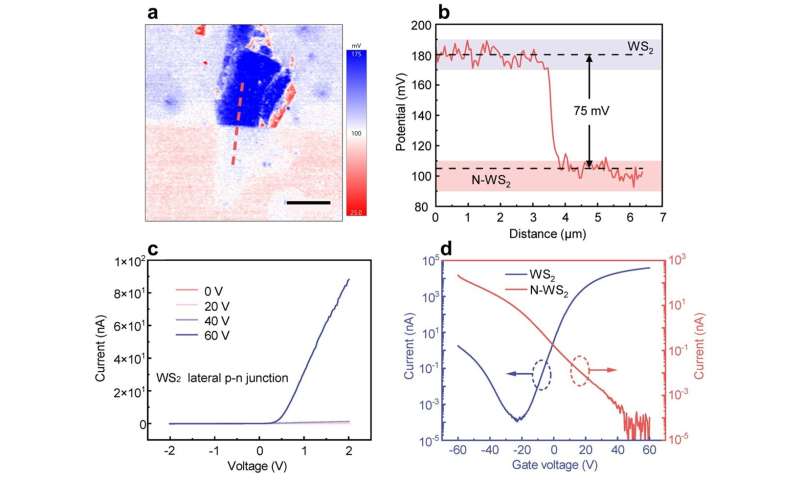This article has been reviewed according to Science X's editorial process and policies. Editors have highlighted the following attributes while ensuring the content's credibility:
fact-checked
peer-reviewed publication
proofread
Low-energy ion implantation enables 2D lateral p-n junction construction

The feature size of silicon-based transistors is approaching the theoretical limit, which puts forward higher requirements for the atomic level manufacturing of semiconductors. The basic idea of atomic level manufacturing is to process and manipulate matters with atomic level precision, which will greatly reduce the power consumption of the chip and achieve a huge increase in the chip's arithmetic power.
2D materials are expected to address the challenges faced by traditional silicon-based semiconductor devices. The p-n junction is the basic unit of optoelectronic devices in the information age.
Previous studies have shown that 2D vertical p-n junctions can be prepared simply regardless of lattice mismatch. However, due to the van der Waals gap in interfaces and the impurities introduced in the stacking process, 2D vertical p-n junctions will reduce the carrier mobility.
The 2D lateral p-n junction can effectively solve these problems. Therefore, how to realize the construction of high-quality 2D lateral p-n junction is crucial for the practical application of 2D semiconductors.
Ion implantation technique is a mature doping method for constructing p-n junctions in the traditional semiconductor industry, which has the merits of controllable doping concentration and depth, abundant doping elements, uniform doping area and non-polluting doping process.
However, due to the high energy of incident ions (tens of keV), the traditional ion implantation technique will cause damage or even penetrate the atomically thin 2D materials during the implantation process, resulting in device failure. Therefore, it is difficult to directly modulate the electrical and optical properties of 2D materials using conventional ion implantation.
In a paper published in Light Science & Applications, a team of scientists, led by Professor Xiangheng Xiao from School of Physics and Technology, Key Lab of Artificial Micro- and Nano-Structures of Ministry of Education, Wuhan University, Wuhan, China, has developed a low-energy ion implantation system for constructing 2D lateral p-n homojunction.
Low-energy ion implantation technique inherits the advantages of the traditional ion implantation technique. It has a lower ion energy and shallower implantation depth, which is expected to address the problem that traditional ion implantation techniques cannot be directly applied to modulate the performance of 2D materials.
Although a few groups have conducted research on low-energy ion implantation, they have mainly focused on the microscopic characterization and defect modulation. To date, there is a lack of research on using low-energy ion implantation to achieve patterned p-type doping on 2D materials to completely reverse their conductivity types and construct lateral p-n homojunctions.
By precisely modulating the implantation dose, the conductivity type of the WS2 flake is successfully modulated, which could be converted from n-type to bipolar or even p-type. The universality of this method is also demonstrated by extending it to other 2D semiconductors. In addition, the photodetector based on WS2 lateral p-n homojunction exhibits satisfactory self-powered photodetection capability.
This work provides an effective method for controllable doping of 2D materials and promotes the practical application of 2D materials.
The authors used the low-energy ion implantation technique to directly implant nitrogen ions into the few-layer WS2, and realized precise modulation of WS2 conductive type by controlling the implantation dose of low-energy nitrogen ions.
-

The measurement results of KPFM and electrical performance on WS2 lateral p-n homojunction. Credit: Light: Science & Applications (2024). DOI: 10.1038/s41377-024-01477-3 -

The photoelectric performance of WS2 lateral p-n homojunction photodetector. Credit: Light: Science & Applications (2024). DOI: 10.1038/s41377-024-01477-3
"By increasing the implantation dose, the conductive type of WS2 can be changed from n-type to bipolar- or even p-type. At the ion implantation dose of 1×1014 ions cm-2, the current on/off ratio of N-WS2 FET can reach 3.9×106. The performance of N-WS2 FET does not deteriorate significantly after three months, indicating the stability of the doping method," said the researchers.
"Low-energy nitrogen ion implantation has been extended to other typical n-type two-dimensional metal chalcogenides materials, such as WSe2, MoS2 and SnS2. Their conductivity types were successfully transformed from n-type to p-type, demonstrating the universality of the method," they added.
By combining low-energy ion implantation technique with lithography technique, the authors realized patterned doping of 2D materials. The WS2 lateral p-n homojunction was successfully fabricated.
"Kelvin probe force microscopy characterizes that there is an obvious surface potential difference in the junction region, and demonstrates the feasibility of constructing lateral p-n homojunction with patterned doping by this method. The p-n junction exhibits significant photovoltaic effect under illumination, and shows satisfactory self-powered photodetection ability under different wavelength lasers."
"Under 532-nm laser illumination at 1.7 mW cm-2, the self-powered photodetector based on this p-n junction can achieve an open-circuit voltage of 0.39 V, responsivity and detectivity of approximately 35 mA W-1 and 9.8×1010 Jones."
The researchers say, "This doping method compatible with integrated circuits shows a huge application potential on modulating the performance of 2D semiconductor devices, and provides a reliable strategy for promoting the practical application of 2D materials."
More information: Yufan Kang et al, Spatially selective p-type doping for constructing lateral WS2 p-n homojunction via low-energy nitrogen ion implantation, Light: Science & Applications (2024). DOI: 10.1038/s41377-024-01477-3
Journal information: Light: Science & Applications
Provided by Wuhan University





















